BIO375 FINAL
1/91
Earn XP
Description and Tags
Name | Mastery | Learn | Test | Matching | Spaced |
|---|
No study sessions yet.
92 Terms
Direct Benefits
Benefits directly to female in mate choice
Resources, etc.
Food given from males (seabirds, scorpion flies)
Ejaculation transfers nutrients (spermatophores)
Male himself is nutritious
Indirect benefits
Benefits to the offspring later
Parental care, good genes, etc.
’Good Genes condundrum”
Indirect benefit? Direct benefit? How does it not go to fixation? How does on tell if another has good genes? Is it based on visible health? Etc.
Runaway sexual selection
Peacocks tail: unnecessary and detrimental to their ability to survive
By proffering males with certain traits females produce offspring that have genes for the trait and for the preference
Eventually females by choosing males with certain traits are also choosing ther preference for the trait
Any skew in females in population can cause preference and trait to runaway in positivitie feedback
mate choice copying
Study in Japanese Medaka show that other females can be influenced by female choice
If the receptive female did not spawn with a male the observer female preferred male with most intense courtship
If the receptive female did spawn the observer preferred that male regardless of courtship intensity
It’s giving they want what they cannot have
If other female desires male that female also desires that female because something must be good about him
intersexual selection
Female choice
intrasexual selection
male-male competition
paradox of the lek
If females choose males with a particular allele then selection will drive allele to fixation
parasite mediated sexual selection
Suppose females prefer male with snazzy display and display is energetically costly
Only males in good health can mobilize energy to display
If male health depends on resistance to parasites or pathogens, then by choosing displays, females acquire genes for health
Genetic variation is maintained because parasite evolves as well, and so which host genes best confer resistance to the parasite change over time
Red queen may be responsible for sexual selection!
number vs quality example
Great tits
Average brood size thats the optimum
Too many it affects survival
Too less not as much fitness advantage for mom
Black billed magpie
Tested different hosts of differing natural clutch size
They had optimum of that natural size
There is a trade off between number and quality
Clutch size produced by a female is close to the optimum for that female
Somehow females assess their ability and the conditions, and adjust clutch size appropriately (conditional mixed strat)
care vs mating examples
Male indigo buntings
Juncos
Male T implanted juncos sang more
Move around more, including leaving their territory more often
Gained more extra pair paternity elsewhere
What might happen if you reduced T in males?
Increase offspring survival through PC BUT
Cost to
Number of offspring increases current attempt
Number of mates
Probability of future attempts
care vs survival examples
assassin bug
Males guard eggs
Guarding has no effect in the lab
In the wild guarding leads to higher egg hatching success due to lower parasitism of eggs
Guarding males have lower survival than either females or non guarding males
care vs future examples
Collared flycatchers
Level of care adjusted in response to changes in potential costs
Evidence for costs both within same breeding attemp and across attempts
Are sexes the same or do they differ?
parental care game (Maynard smith’s)
Males: care or desert
Females: care or desert
Move care vs less care
Built in biases based on difference between sexes
Survival of offspring depend on number of care-givers
S2>S1>S0
Number of offspring in current brood = w
If male deserts he has probability (p) of acquiring new mate
He will continue to desert this mate as well
It only goes as far as mate number 2, so after it does not matter
If female deserts she ALWAYS finds new mate, has fecundity = W (sometimes 2w but not always)
She also continues to desert the second mate and ends at 2
Assumptions
Males and females equally good at care
Strats are fixed
If biparental care it would result in wS2 for both
If male deserted and female cared it would be wS1 for female and wS1(1+p) for male
If both male and female deserted it would be WS1 for female and wS1 for male
If the female deserted and male cared it would be WS0 for female and wS0(1+p) for male
When should both sexes provide care?
When switching by either sex is not better, so
Females care when wS2>WS1 and
Males care when wS2>wS1(1+p)
Value of care is important!!
If S2 is not much more than S1 then no incentive to stay
Opporotunity for additional matings is important
Value of p affects desertion by males
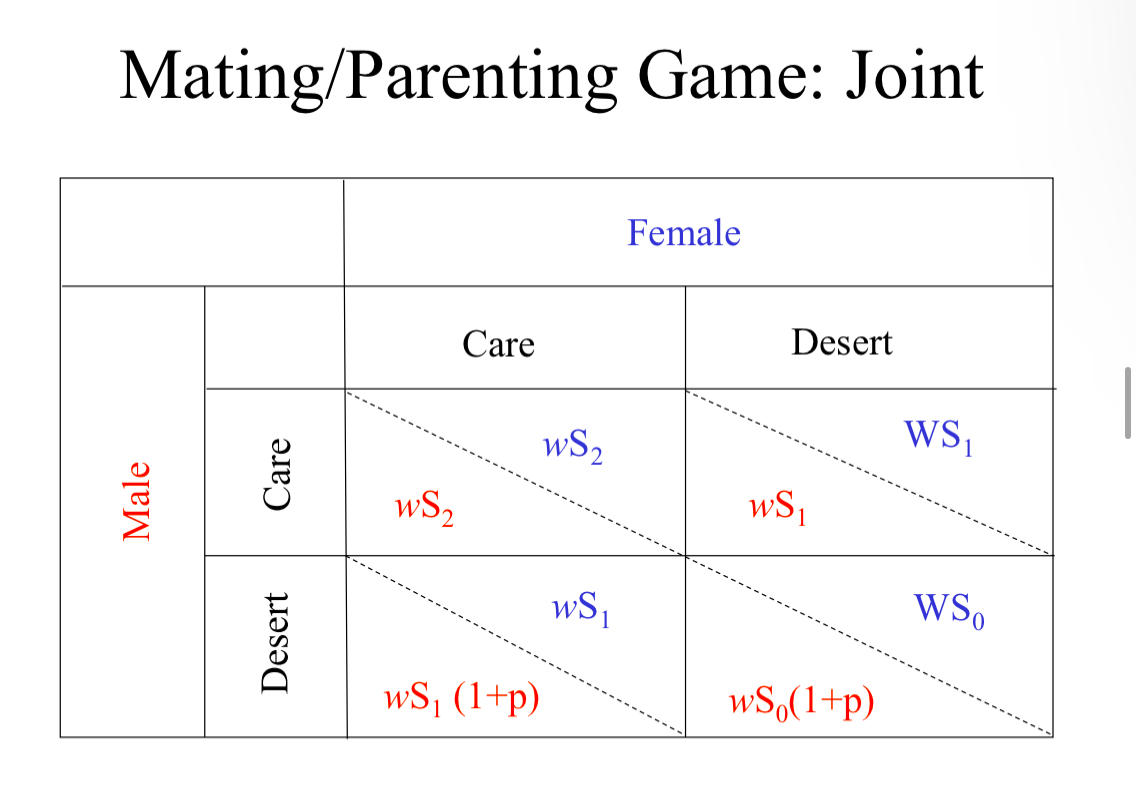
parental care, parental effort, parental investment
Any trait in parents that increases offspring fitness
The cost of parental care to the parents fitness
Often measured by its effect on other activities
lacks’ hypothesis
As number of offspring increases there is an increase constraint on fitness
As the number increases the survival of offspring decreases
There is a predict intermediate optimum
Conditions for monogamy
Few mating opps
Females dispersed
Female Voles clump when food clumps
Female voles disperse when food disperses
When clumped males follow females and are not monogamous as greater opp to mate
When disperses males follow females and are monogamous as less opp to mate
Females respond to resources, males respond to females
Biparental care esp. valuable S2>>>S1
Ex. Seabirds
Female female aggression
Ex WOLVES
Alpha female receives male care and attention
Limits p for male
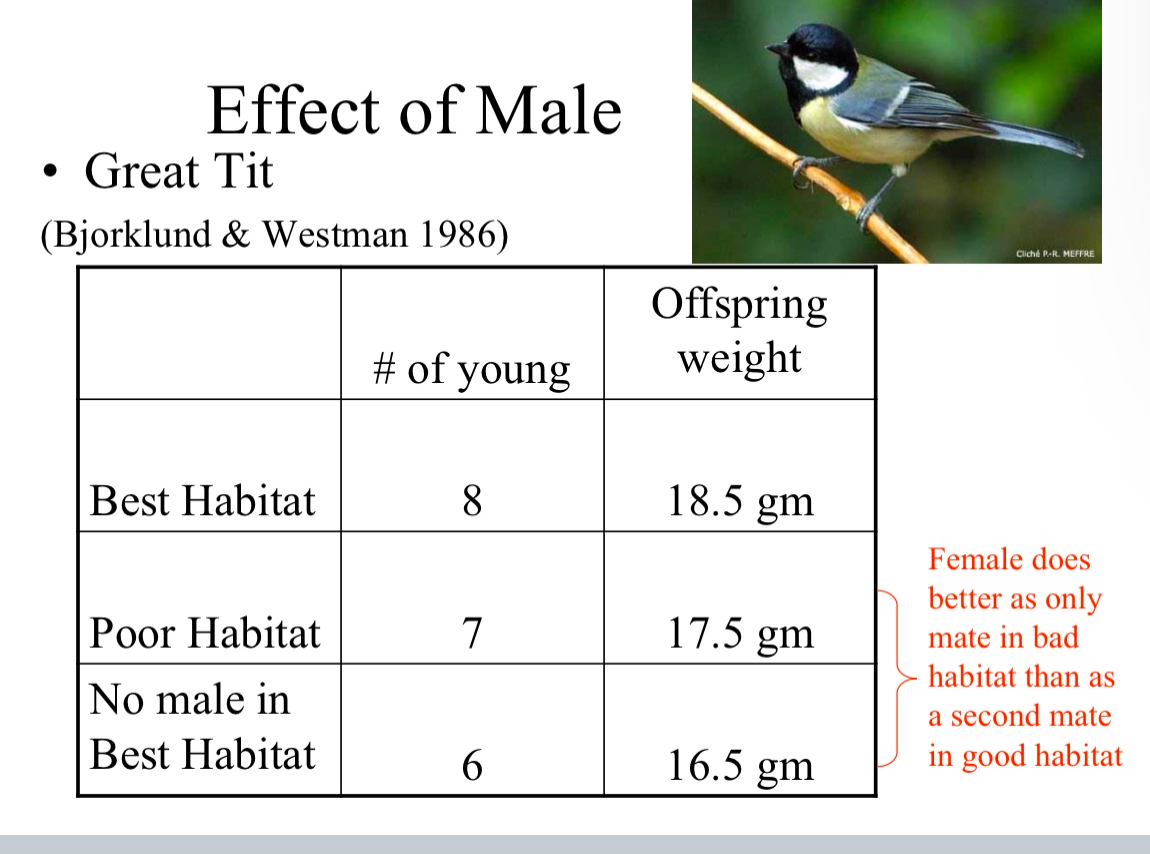
conditions for polygamy
Shirking cichlids
Maternal care very valuable
S1>>>S0
Paternal care of modest value
S2=S1
Many mammals
Resources held by males offset any difference between S2 and S1
Mating opportunities high (high p)
– Mammals: Harem defense due to female clumping
because of predation
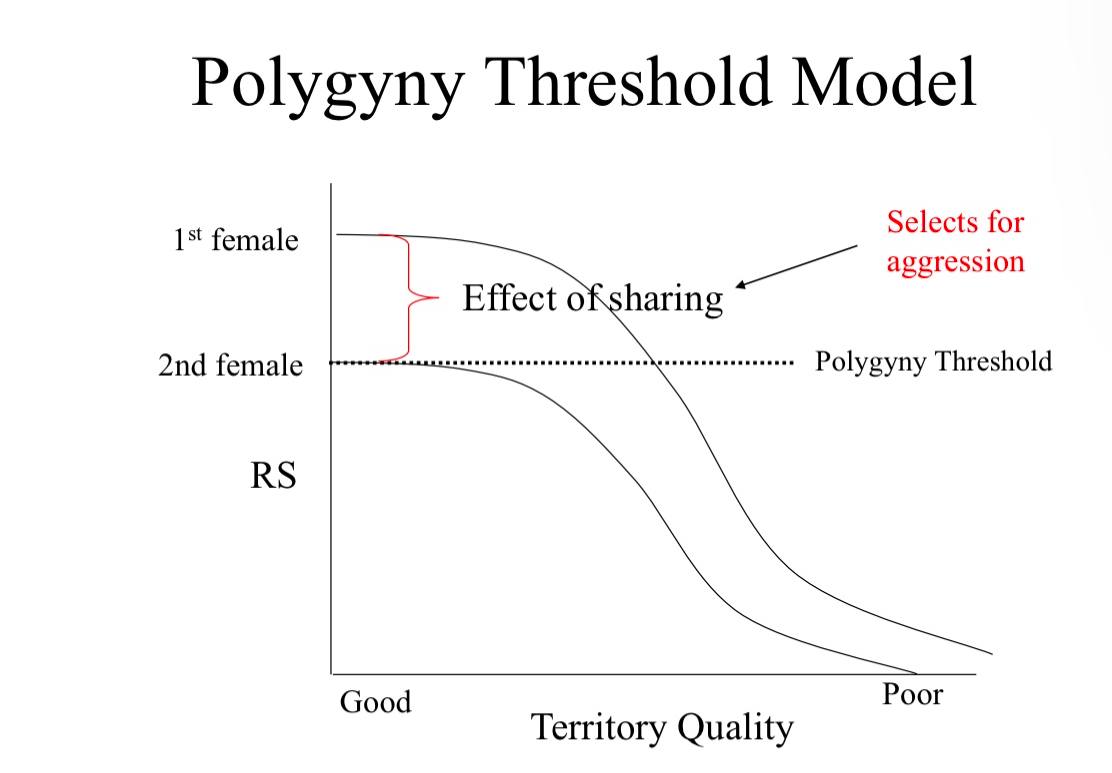
conditions for polyandry
maternal care adds little to parental care
W is really big compared to w
Example spotted sandpipers
Rich habitat, females can relay eggs quickly
Paternal care highly valuable
Either S2=S1 >> S0 or S3>S2
Example sea horses
Male brood pouch
Fish
Males defend spawning sites and stay there
Low p for male
Skewed sex ratio (spotted sandpipers as well)
Female choice
Strongly avoid already paired males
conditions for promiscuity
Parental care has no value to offspring fitness, and or remateability is very high
Desert is the evolutionary stable strat for both parents
S1 =~ S0
p for males and W for females perhaps both large

Sexual conflict
Traits favoring particular mating pattern in one sex (e.g., polygyny in males) are costly to other sex (females) and vice-versa (polyandry for females)
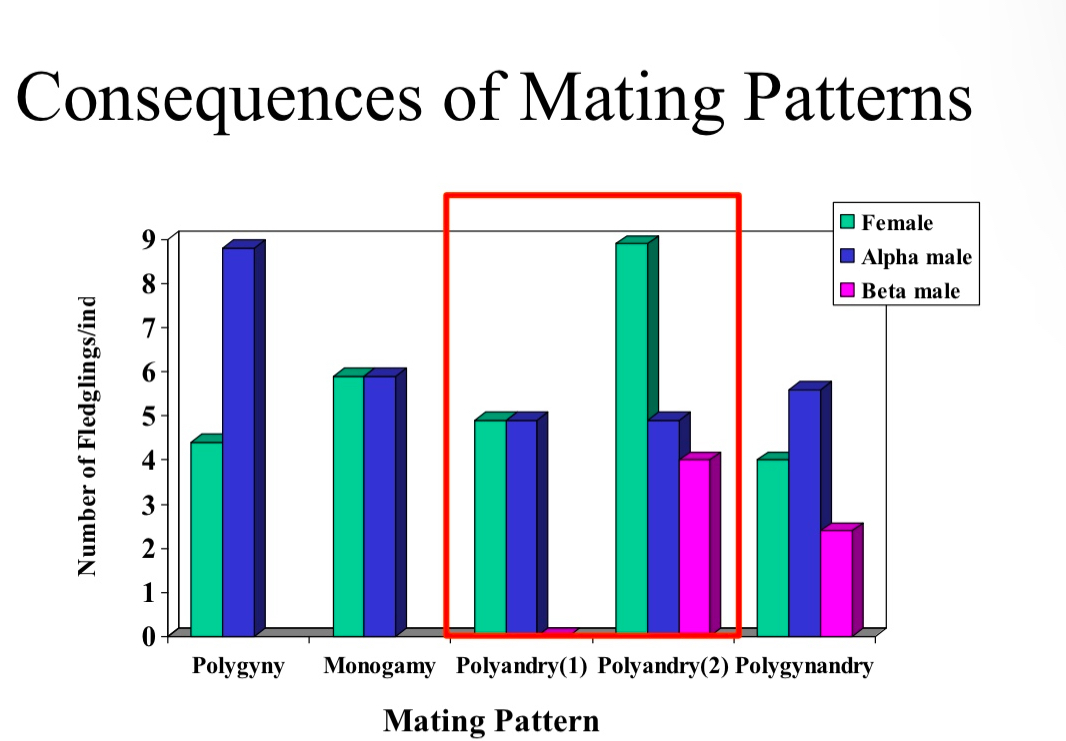
Dunnocks example
Complex mating systems
Monogamy for some, polyandry for some, polygyny for some, polygynandry for some
The larger the female territory the more males within it
Small territories with two females more likely to be polygynous
REMEMBER OPTIMAL TERRITORY SIZE MODEL
Benefit/resource gained vs cost of defense
Polyandry is good for females
Polygyny is good for males
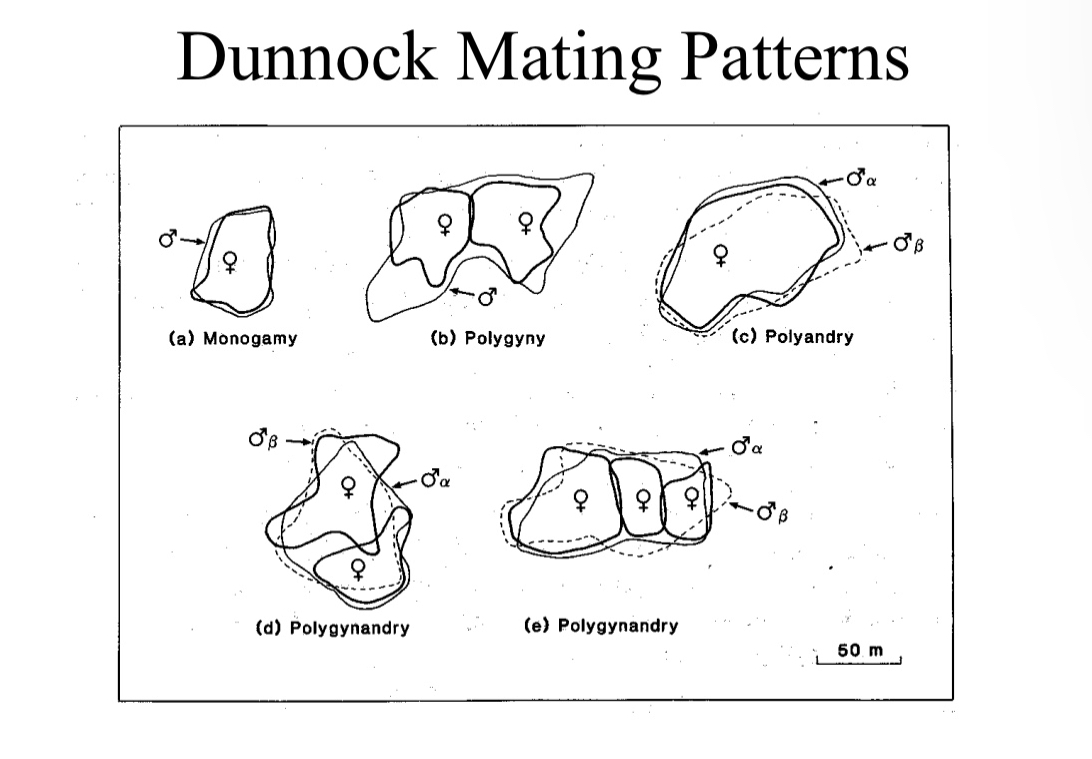
Conditional polygny example
FERAL HORSES!!!!
My favorite example tbh
Dominant male and group of females
Key resource: water
Permanent ponds
Ephemeral: dependent on weather
When more females more clustered males will take on larger harems
When females are dispersed males are more likely to follow monogamy
Polygyny is increased with distance from permanent water source and decreased with more precipitation
Im ABSOLUTELY using this example on the test if given the opp
Horses are my fav
promiscuity example
Lotta insects
phylogenetic analysis of mating systems
Cichlid fishes and their species
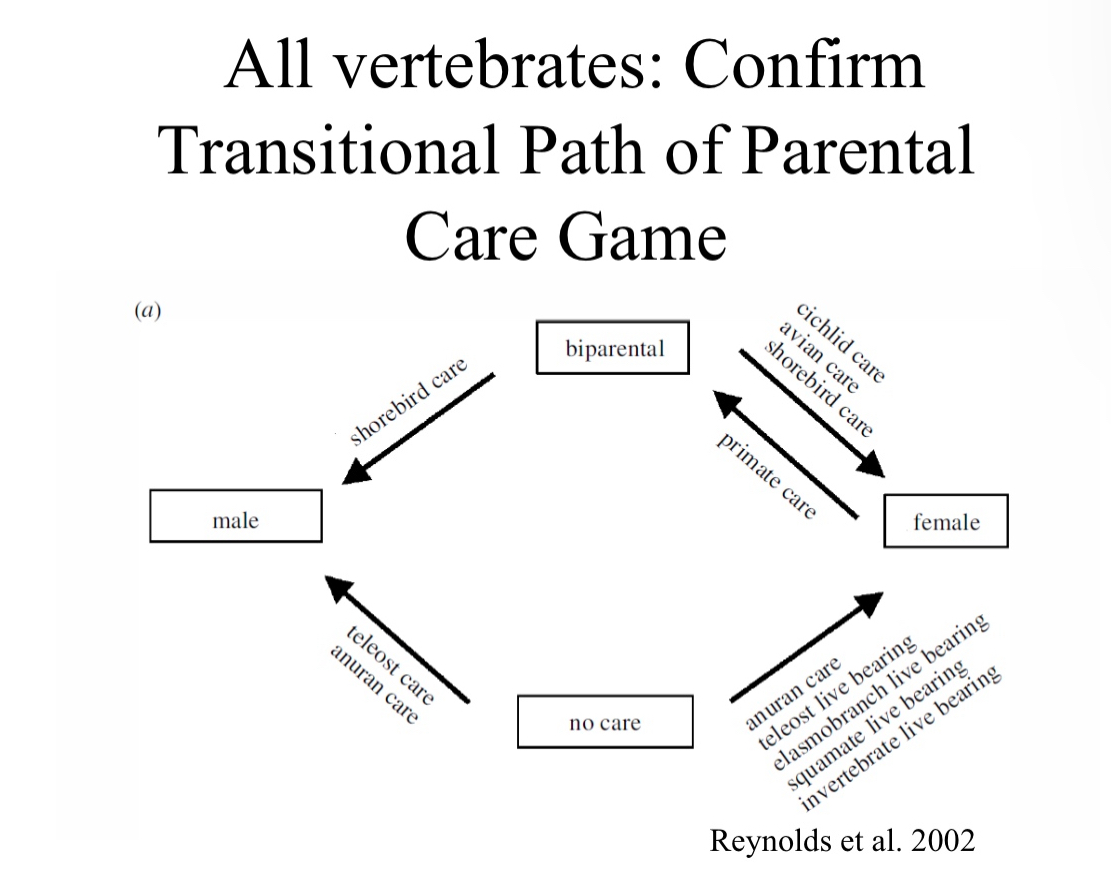
Polygyny threshold model
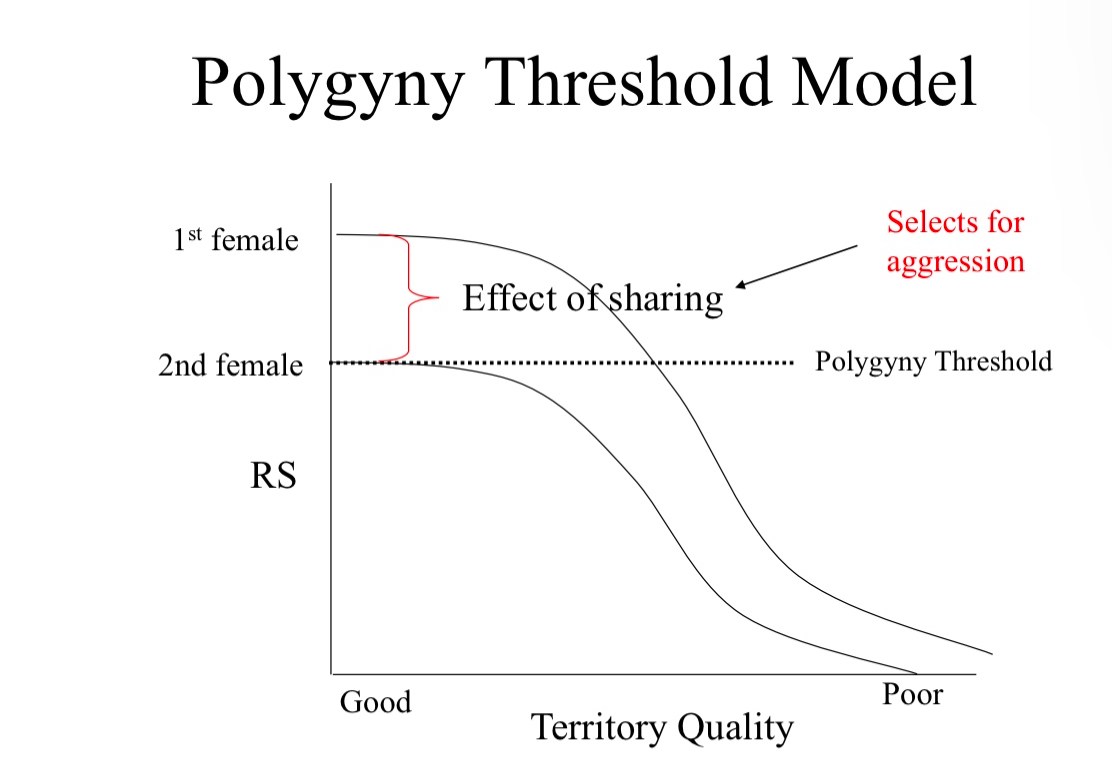
why live in groups?
protection from predators (vigilance, dilution, protection/group defense, selfish herd, confusion), increased foraging success (synergy, cooperation, information), information center
Costs
Competition for resources
(Exploitative, interference)
Cost of aggression
Increased exposure to disease/parasites
Limited choices of mates
why live in groups? Examples
Starlings
Able to respond to predators more quickly with more pairs of eyes
Red wing blackbirds
Breeding synchrony that has many birds together, less chance of being killed with so many other birds around
musk ox
Multiple individuals respond to threats and drive off predators
Get into defense formations
Fish schools and bird flocks work on confusion
Black headed gulls
Captive birds in flocks consumed more fish than solitary birds
Fish fleeing one headed to another. Easier to catch
Wild dogs
Live in permanent social groups
Hunt together in a pack to help increase chances of success
Larger packs foraged more often
Had to chase prey over a shorter time
Less energy expended and more energy gained
Fruit bats
Dilution and also gain social information
development of locust swarms
arise from combination of two individual traits (Buhl et al. 2006):
1. Developmental plasticity in the face of density
2. Responses to other locusts
Plasticity: The ability of a genotype to produce multiple phenotypes in response to variation in environment.
Developmental plasticity is an effect of environment early in lifetime that has life-long impacts. [Tinbergen’s 2nd Question!]
Youngsters have two morphs:
1. Solitaria: Avoids other locusts
2. Gregaria: Attracted to other locusts
Developmental switchpoint
- depends on density
-solitaria occurs at low densities
(Think of solitary)
-gregaria at high densities
(Think of real social George)
Gregarious locusts try to eat other locusts
Cannibalisitic
(Spiders georg, hes real lonely and social and eats a bunch of spiders which isnt really cannibalism but hes a little freak nonetheless)
higher density causes high exploitative competition for normal food, leading to search for protein and salt
found a locust’s response to attempted cannibalism, cued by another locust approaching and touching from behind, is to…run away!
Combination of attraction to others and avoidance of cannibalism is that all locusts end up running away in the same direction. Produces a “marching” swarm.
Individuals revert to random movements when solitary, but ‘coordinated’ movements when together.
Once the youngsters mature the swarms become plagues
kin selection (Hamilton’s rule)
Individuals most likely to carry unexpressed genes are close relatives. “Kin selection” might favor altruism if it is directed toward relatives.
Altruism among relatives may be favored
Example 1: Parental Care
Parent provides benefit to another at cost of itself
Why does this evolve?
Copy of gene for parental care likely to be in offspring, so if benefit is high and cost is low, then the parental care allele helps copies of itself!
The most likely other individuals with copies of a new allele are offspring.
THREE variables are important
Cost to actor (C)
Benefit to recipient (B)
Probability that recipient shares a given allele with actor, called relatedness (R)
A form of conflicting demands, with fitness components in separate individuals
RB>C is conditions needed for altruism to spread
reciprocal altruism (prisoners dilemma game, tit-for-tat solution)
Be altruistic to someone who will later be altruistic back to you
Current cost
Delayed benefit
Delays make this susceptible to cheating
vigilance
More eyes looking and warning about predators
dilution
If predators forage at constant rate, then joining a larger group dilutes the risk
selfish herd
predator attacks from outside
– safest place is toward middle, with others in the way
additional clustering during attack
Bird flocks, fish schools, and ungulate herds spread out when foraging, cluster tightly when attacked
Example liostenogaster wasps
Ants attack outside
Wasps attack anywhere
Nests more clustered where ants but not wasps
information center
Improved foraging via information
Successful foragers return to center and tell others how they were successful
Cliff swallows
Most successful in larger group
More likely to follow a good forager when leaving a colony
Rats
Three arm maze with random food
Sniff demonstrator rat who had smell of the day
Test subjects went to arm with food
Altruism
Any action that benefits another at some cost to the actor
relatedness
The probability of sharing a particular allele that is identical by descent.
Relatedness is not the proportion of alleles shared, but the probability a particular allele (a new mutation impacting altruistic behavior) is shared.
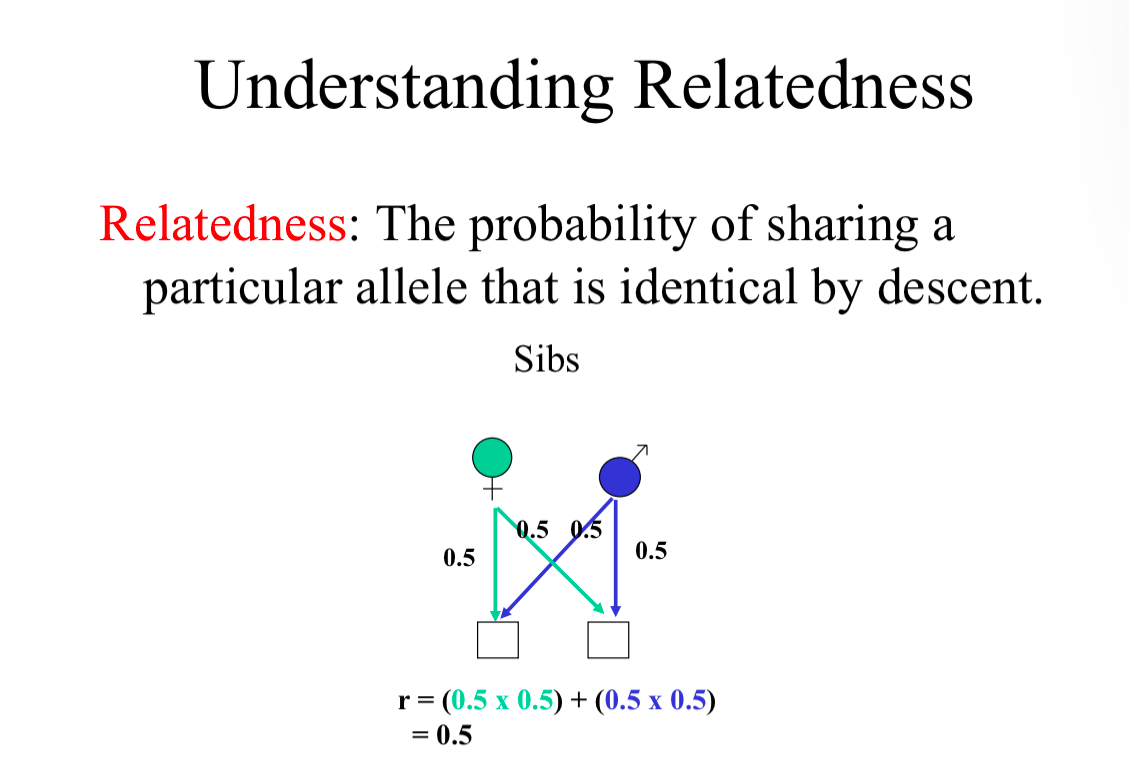
reciprocity
Mechanism
Organism acts altruistically towards another on the basis that it will receive the same in the future
eusociality hypotheses
haplodiploidy hypothesis, queen control, monogamy hypothesis
haplodiploidy hypothesis
Sex determination is haploidiploid
Females are diploid and arise from sex, males are haploid and arise through parthenogenesis
Affects the pattern of relatedness
Sisters relatedness to brothers = 0.5 avg
Brothers relatedness to sisters = 0.25 avg
Females have a higher relatedness with sisters (0.75) Than daughters or sons (0.5) or with their brothers (0.25)
Male offspring are equally real tend to brothers, offspring, and sisters (0.5)
Bias for altruism by females to their sisters
Sex of recipient of help matters
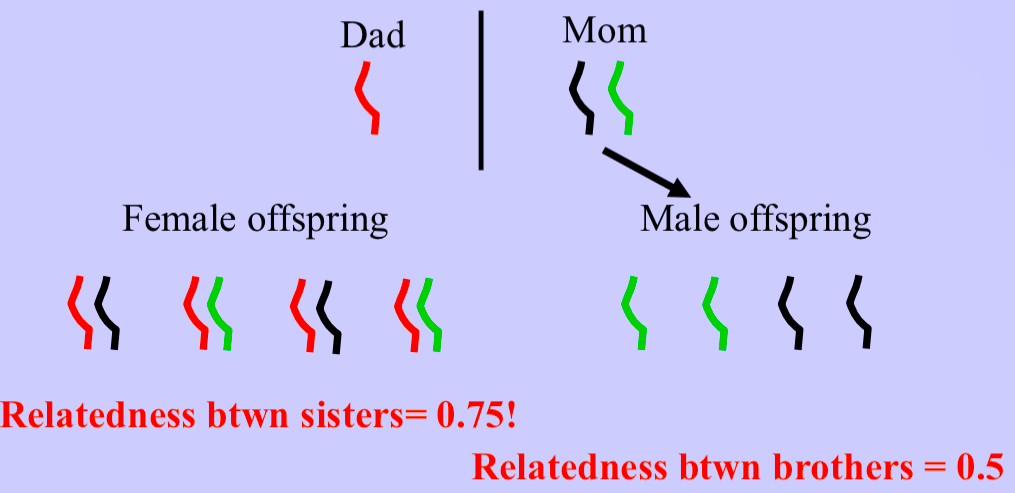
queen control
Queens related to offspring equally (0.5) so she prefers a 1:1 sex ratio
The monogamy hypothesis
Females mate with just a single male
0.5 relatedness between all siblings
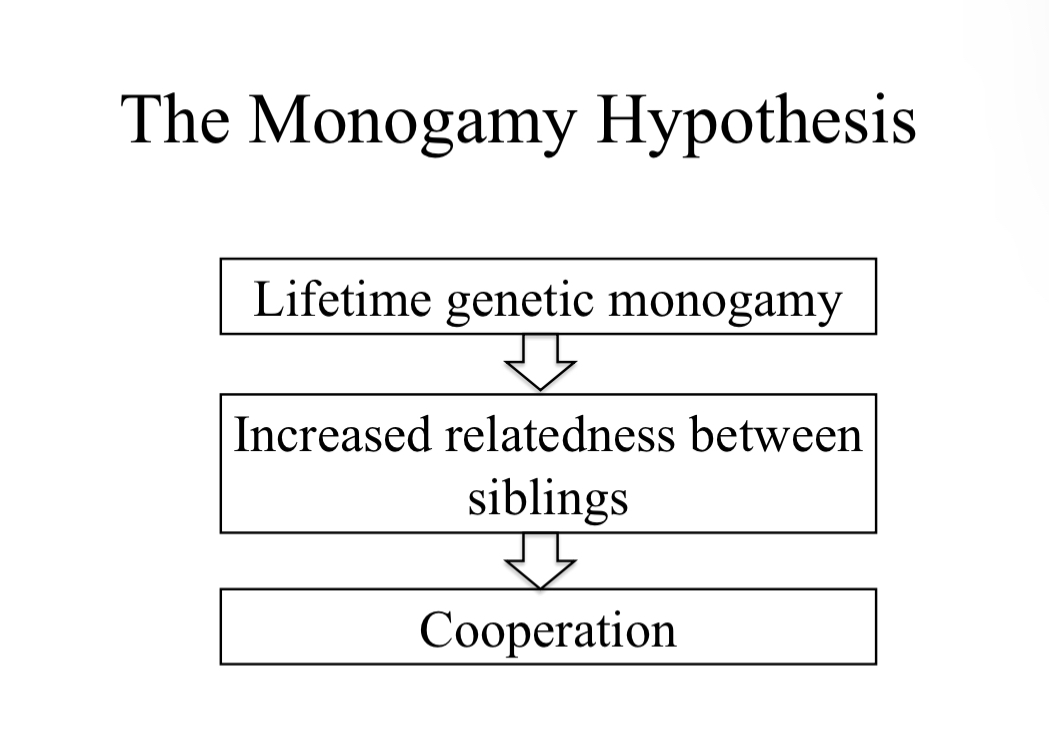
hyymenoptera (bee, ants, wasps) example (eusociality)
Arose from subsocial route
All haploidiploid but not all eusocial
Ancestry monogamous
termites example (eusociality)
One breeding pair, lots of sterile workers
Male and females diploid
King remains with colony and assists
Workers are both male and female
No obvious genetic bias
Direct benefits: sharing symbionts
Wood low in nutrients so they share these to help digest
High cost of dispersal
If young adults unlikely to breed on their own kin selection would favor caring for kin instead
Cyclical inbreeding can create biases in relatedness
Sibs r=1
Offspring r=0.5
Termites are generally monogamous
Some are inbred but many are not
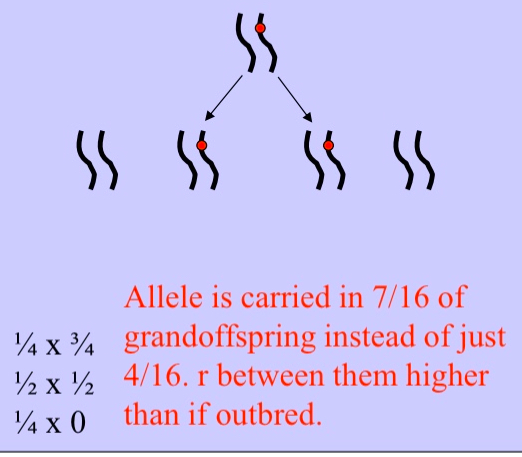
naked mole rats example (eusociality)
One of only 2 eusocial vertebrates known
Blind and hairless
Subterranean
One queen
3-4 male breeders
Males stay with queen and help some
Male and female offspring of queen are workers
Division of labor: soldiers, foragers, care-takers
Reproduction suppressed by queen aggression
New colonies form by fission
Benefits: food hard to find, colony defense
Very difficult to disperse because of environment
High similarity in dna between moles in a colony
0.85-0.95
High similarity due to inbreeding (equivalent to 60 generations of sib-sib mating)
High r through inbreeding
Low fitness to solitary led to long lived associations leading high relatedness through inbreeding
Genetic relatedness then contributes to who helps who
Eusociality
complex social system with overlapping generations, sterile worker castes, and cooperative care of offspring
Workers give up personal reproduction
Little cost to help big benefit to help
Subsocial pathway to eusociality
helpers are offspring that stay in the nest and help care for siblings
Helpers sacrifice more reproduction than in parasocial groups
parasocial pathway to eusociality
multiple founders sets come together to reproduced in the same nest
Mendel’s law of segregation
mechanism
sex ratio
males 2x big as females, so females produced more
Fitness depends on expense of producing male or female and their reproductive value
Reproductive value is the expected lifetime RS of an individual
Sex ratio in ants example
sex ratio reciprocal of weight ratio 1:1, implies queen control
Sex ratio 3:1 with emphasis on females, implies worker control
Ants match 3:1
sweat bees
Have both parasocial and subsocial nests
Subsocial nests: workers should allocate more to females as they help and are more related as sisters under the queen
Parasocial: workers should allocate equally to female and male as workers will replace queen eventually and have similar relatedness to nieces and nephews
Sagebrush crickets example
nutritious males
Females chew on males wings
Hemolyph consumed from wings
Virgin males prefered
Strength of preference depends on food supply
Damselfish parental care
males court from nesting sites
Females lay eggs at site and move on
Males will cannibalize some eggs
Males who court more intensely are less likely to cannibalize and more likely to defend eggs
Females prefer to spawn with more intense courter
Parent care indirect or direct?
Both!
If male takes over care its direct
If male helps with care it’s indirect
Can be both simultaneously
Sticklebacks example in parasite mediated sexual selection
female prefer males that have brighter red
Bright red is carried by males in good condition
Parasites cause reduction in male red color
Females can identify parasitized males by red color
Not clear if direct benefits or good genes tho
Red necked pheasants example for parasite mediated sexual selection
females prefer to mate with males having longer spurs
Males with long spurs are older, larger, and have higher survival
major histocompatability locus MHC
Males with long spurs tend to have similar MHC genotype within a year, but different accross years
For example all long spurred males in 2024 would have simialr genotypes but different to the long neck spurs of 2018
Offspring of females mating with long spur males have higher survival
We do not know what parasites are involved and how they maintain variation
It’s giving coevolutionary arms race of evolving genotypes
Waxmoths sexual selection
Females prefer males with higher Pulse-
Pair-Rate (PPR) calls
• Playbacks of bat calls caused males to pause
in “singing”.
• Playbacks of bat calls near preferred males
erased female preference.
Males more likely to silence when alone
Good males in a crowd of wimps are less likely to silence
Good males in a crowd of studs are EVEN less likely to silence
Male-male competition
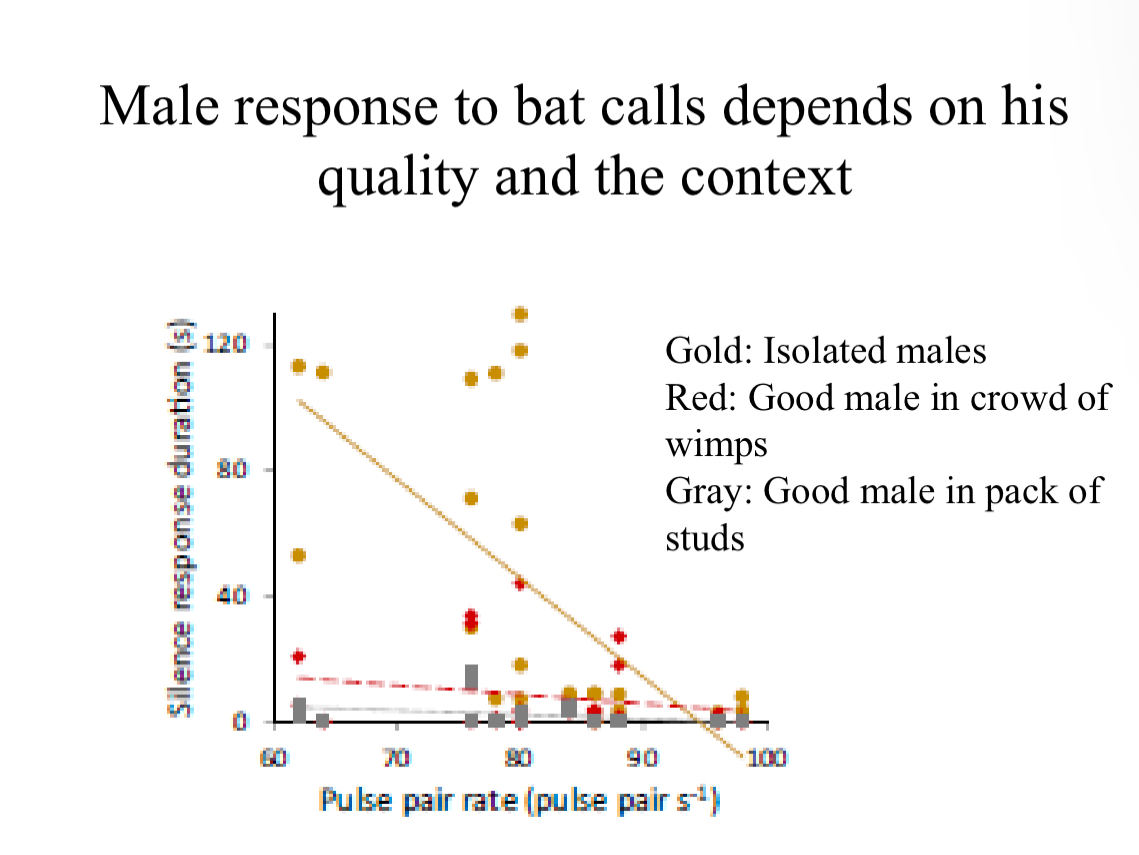
Implications of anisogamy
Males: strat. Of finding mates
Females: strat. Of improving offspring survival
Conflicting Demands
When a change in a trait (tendency to
provide care) increases one component of
fitness (offspring survival) and decreases
another.
Juncos example
Altered testosterone in males
Altered testosterone in females
Capture a subject
Slide a slim plastic tube of either T or empty under skin
Superglue, release
Females appear to have compensated for the loss of PC
Complete removal of males led to slower growth, slightly fewer offspring
Male PC also affected female juncos
Less care means female in not as good shape, more mass loss, renested later
T implanted females brooded less and were less aggressive to nest intruders
Lower brood survival
Biparental care example in house sparrows
both parents provide food for 15 days
Do they follow theory of optimal parent care?
Pair feeding rate increases offspring mass
Exp
Two nests with nestlings the same age
Observe 2h (PRE stage)
Swap 2 nestlings from one to the other
Observe 2h (MANIP stage: reduced vs. larger)
Repeated over 4 years
No effect at PRE
reduced declines
Larger increases
Parents adjust work level to number of mouths
But they do not fully compensate so all nestlings do worse
And apparently the level of food available affects how willing they are to extend themselves
And this may be adaptive behavior given their ability to renest
Conflict
When a trait in one individual increases their fitness but decreases the fitness of a social partner
Types of parental care strats
sealed bid = fixed strat of amount of care
Negotiated = conditional mixed Strat depending on something about partner
Example of pair coordination PC, long tailed tit
paretns alternate visits more than expected by chance
Alternating also resulted in synchrony
Pairs with higher metrics of these delivered more food and suffered lower nest predation
Burying beetles
Find a dead animal, typically a mouse
Roll into ball and bury it
Lay eggs in soil nearby
Join defense of carcass and eggs
When larvae hatch parents regurgitate partially digested carcass to larvae
Exp
Added weight to parent
Reduced care when weighted
Increased care from the partner of the weighted
Only partially compensated for partner tho (male more for female)
Shirking cichlids
how might conflicting demands keep both partners from shirking?
Value of care is important
Opp to remate is important
Polygyny via deception
Pied Flycatchers
– Territorial, defend cavity
– Female benefits from male care, avoids
already paired males
– Once paired, some males defend second
territory away from first
– Attract second female, then care for offspring
at first nest; second female either deceived or
delayed
3rd Q: evolutionary history
What were the sequences of changes leading to present day diversity in mating systems?
Were there certain kinds of transitions that are more common?
Integration of 3&4
What were the sequences of changes leading to present-day diversity in mating systems?
Were there certain kinds of transitions that are more common and what might have been the selective forces acting during those changes?
Can transition from
biparental to only male
Female only to no care
Biparental to only female
Male only to no care
And vice versa
CANNOT transition
Biparental to no care
Or
Male only to female only
And vice versa
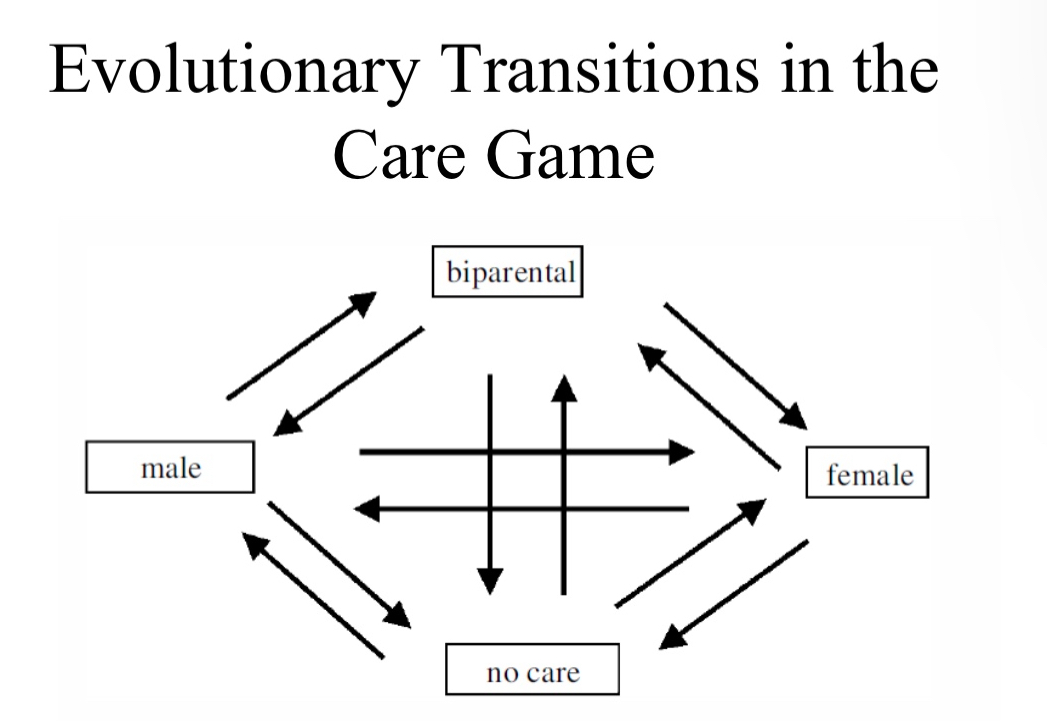
Aggregation
Groups of individuals who act independently but arrive at same place and time
Ideal free distribution describes aggregation, unless social cues are used.
Many animal groups are more than this.
Emergent property
collection or complex system has this, but which the individual members do not have.
Quroum sensing (ants, bees, ungulates)
Individual process of assessing options, communicating to others.
– Others also assess options, and the weight of individuals for or against a particular option leads to a decision.
Dominance in coral dwelling gobies
based on size
Only dominant individuals breed
If subs get close in size to dom the dom becomes increasingly aggressive and evicts sub
Subs try not to grow too big so avoid food sometimes
Dwarf Mongoses altruism
breeding pair and their older offspring, with some immigrants
Multiple aspects of helping behavior
– Sentinels
– Foraging
– Grooming
– Lactating
Indirect benefits
Kin selection
Delayed direct benefits
Queuing for breeding spot
Relatedness decreases over time with sub age regardless of origin
helpers increase number of offspring
Breeding is hard to achieve when young as easier when older
Some may disperse as they get older to nearby group
Pied kingfishers in kin selection
Young fledglings increases with help
Primary helper is always a male offspring of breeding pair
RB>C
Secondary helper is usually an unrelated male
R=0
Only help when breeding is difficult on unrelated male (low C)
Can benefit: secondary helpers sometimes pair with female later (RB=0, but right side of equation may actually be negative because chances of breeding are higher if help)
Relatedness does affect likelihood of helping, but so does B and C too

Superb fairy wren
Breeding usually occur in group of three or more
Having at least 1 helper increases success
Helpers also increase female survival to next year
But over 80% of offspring are EPP
Helpers typically unrelated due to this
Genetic monogamy vs cooperative breeding
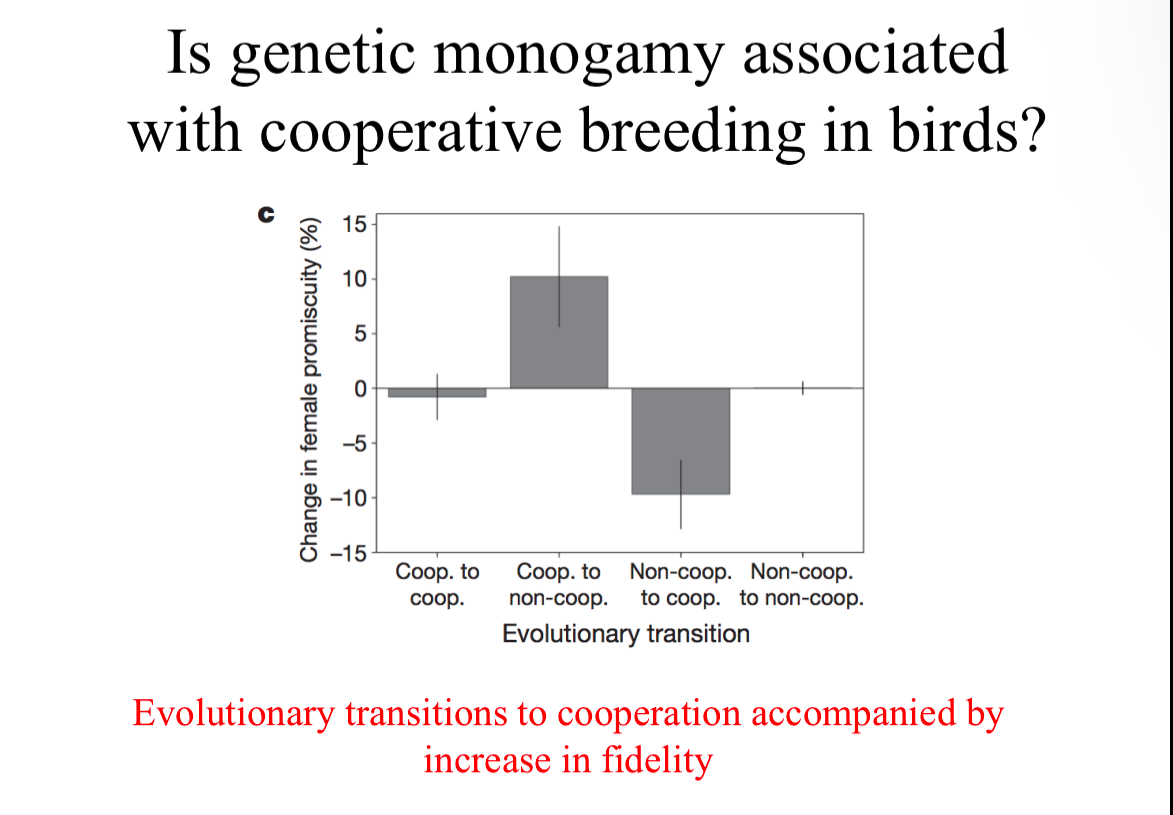
Monogamy hypothesis alternative 1
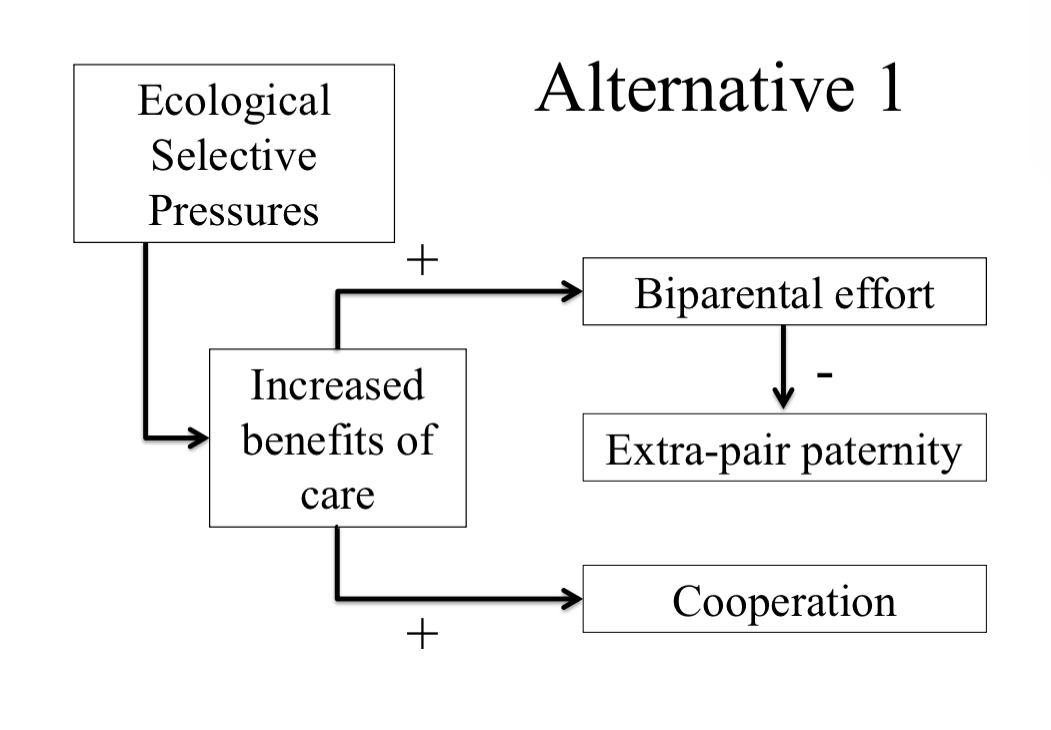
monogamy hypothesis alternative 2
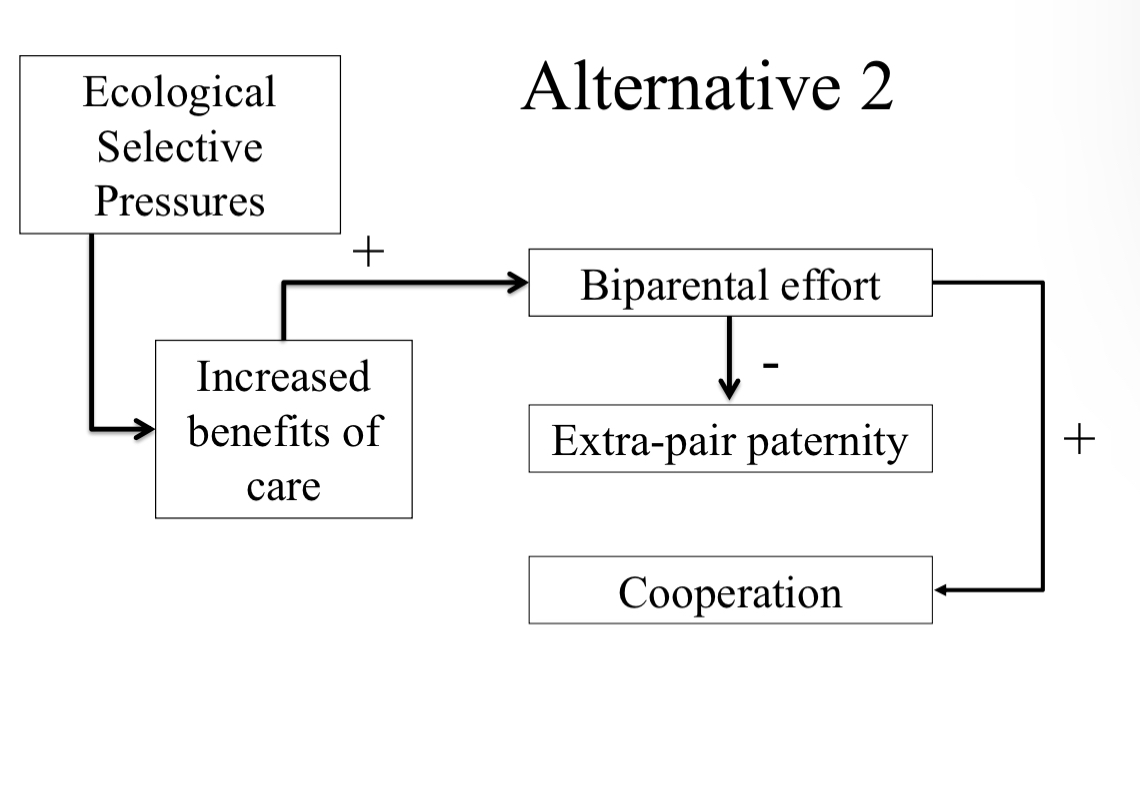
Mechanism/Development and Kin Selection
1. Grow up with kin, so very familiar individuals
are likely to be kin
2. Unknown individual resembles a known relative
(phenotype-matching)
3. Kin are like yourself (self-referent phenotype-
matching or “armpit effect”)
Golden hamster example for phenotype matching
Swapped pups among broods at < 12 hrs; 1 foster and two normal pups per female
When mature (41-61 days later), tested response to flank-gland odor from different individuals
Non sibs reared together (foster sibs)
True sibs reared apart
Non sibs reared apart
They are wait the least to investigate non sibs, then foster sibs, and wait the longest to investigate true sibs
Hamsters distinguish social non-sibs from unfamiliar individuals (match to social relatives)
Hamsters distinguish unfamiliar sibs from both social non-sibs and from unfamiliar non-sibs (match to self)
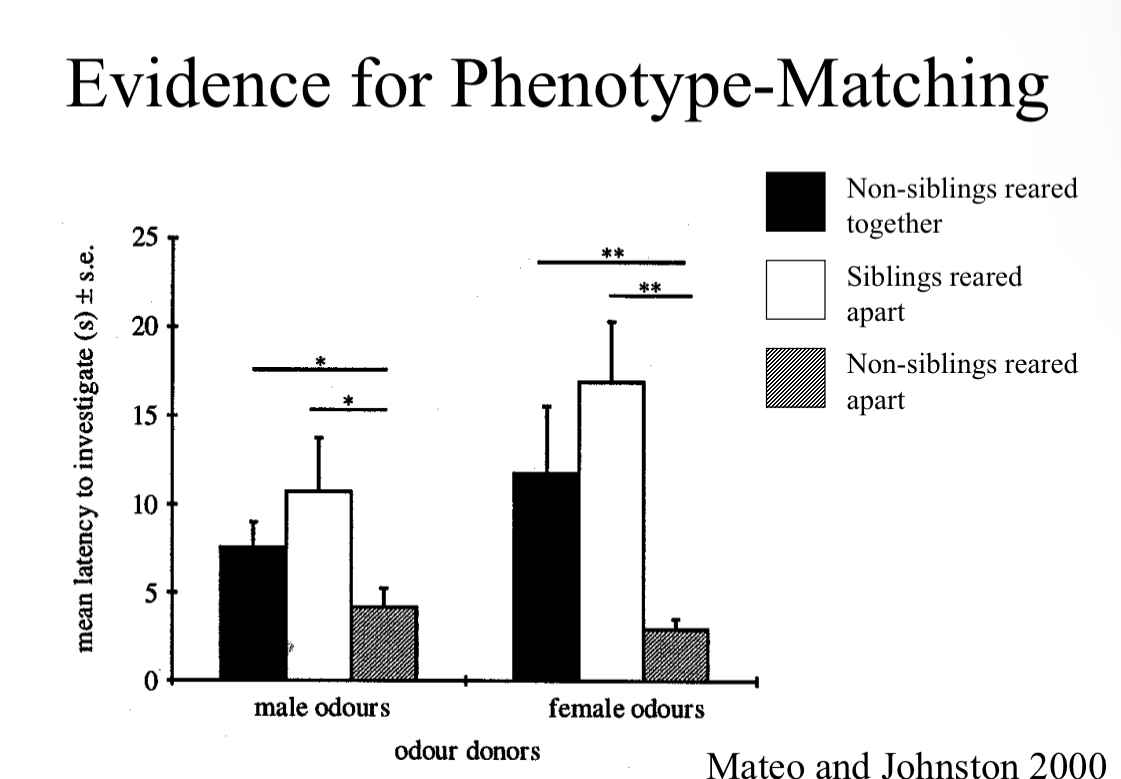
Kin recognition in plants (Sagebrush)
Plants often avoid self-pollination
• Roots in some plants grow less if they bang into a relative vs non-relative.
Sagebrush emits a volatile chemical if chomped on by herbivore
Neighbors synthesize defense compounds more when such chemicals are released
Significantly more plants had more damage on side near damaged non relative
They then used air from a damaged plant in a similar design
Same thing!
Plant warned their relatives more effectively
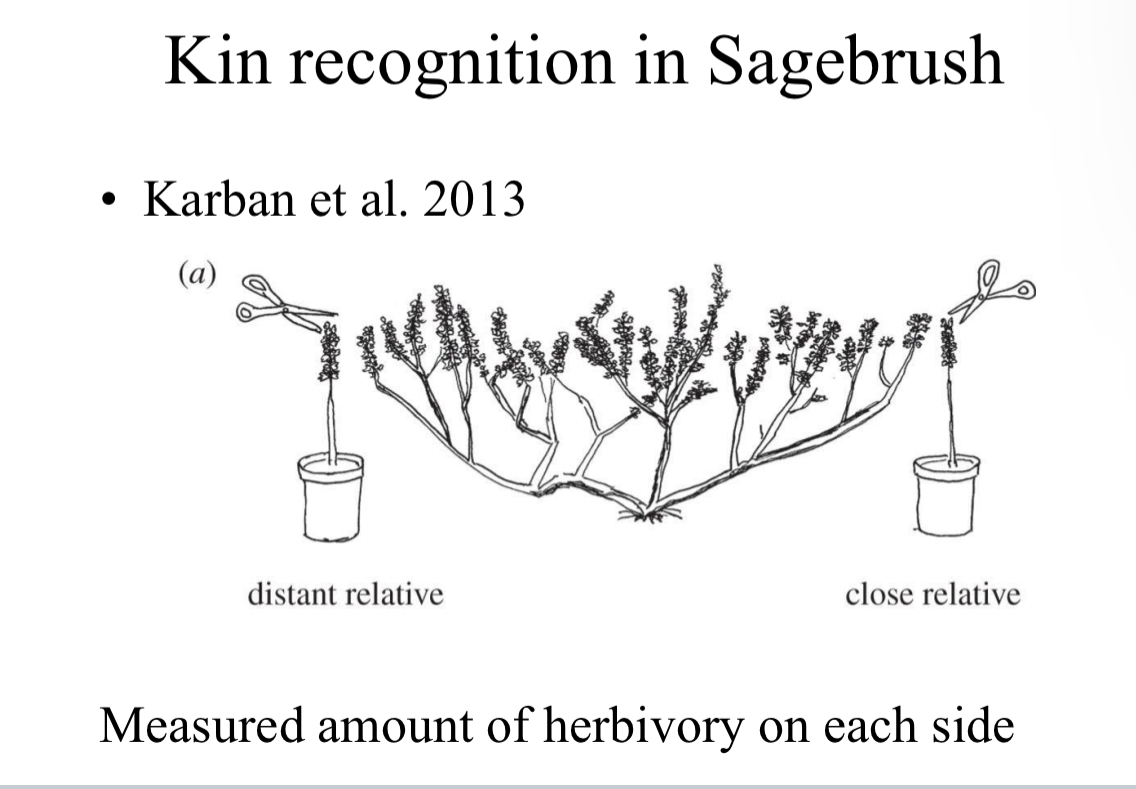
Mutualism
a relationship between two species of organisms in which both benefits from the association
By product mutualism
cooperation as a collateral effect of selfishness, in which each derives a fitness benefit
Prisoners dilemma
You and companion captured, put in different cells.
• Police give you an offer: If you inform on your “friend”, he’ll be put away for long time and you get to go free. If you stay quiet, you both go to jail (short time).
• What do you do?
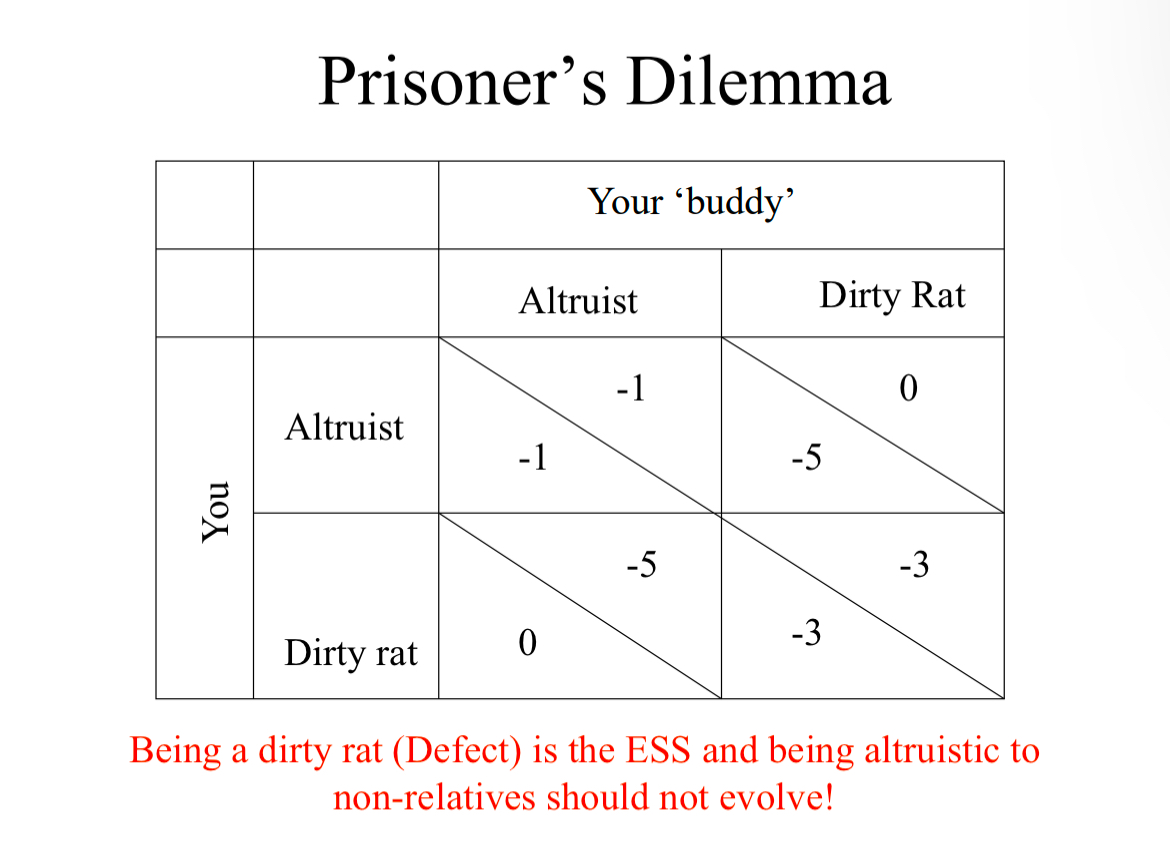
Tit-for-tat
Cooperate and then do what partner did last time
Required an additional condition that the game is played repeatedly and participants remember what their ‘friend’ did last time.
‘Forgiving’ Tit-for-tat even more stable
Vampire bats
Colony-dwelling, mix of related and unrelated females
• Bats regurgitate food to offspring and to others
• Individuals groom others as well
• Food-sharing has asymmetric C and B (C < B)
Cost less than benefits
Problem in bats = groups compose of kin
Kin selection might maintain this
Likelihood of food-sharing explained more by past food received and grooming than by relatedness.
No evidence that recipients harassed donors into sharing.
Guppy predator inspection
Live in groups
Predators cause groups to become tighter, except a few individuals who swim to danger
Predator inspection fits with the prisoner dilemma
Solitary individual (sucker) receives high cost
If several coop then cost is lowest
If everyone defects cost is intermediate
Do guppies play tit-for-tat?
Exp
Guppy at tank with pred at end and an observer to see how they react to an altruist or a defector
They do!
If the other fish is ‘nice’ they react nicely and if they defect they ‘retaliate’
Reciprocity and Tit-for-tat in Humans
• Strong bias toward familiar individuals
• Some effect of cost and benefit
• Aid-giving may depend on the nature of prior interactions with that specific person and the ‘trust’ you have in them
Meriam People: Signaling and Hunting
Men spear fish and hunt turtles; elaborate cultural practices linked to this activity
– Women collect shellfish; no special events
– Shellfish are much better energetically and nutritionally
– So why do men make poorer choice of spearing fish or hunting turtles, and why is this celebrated?
Hypothesis: Activity is a signal.
Turtle-hunters had higher reproductive success
• More social recognition
• Attracted better quality and younger mates
• Had more mates over lifetime
– Best spear-fishers are well-known, conspicuously
display catch
Evolutionary Psychology
Human behavior made up of Complex Conditional Strategies: Sophisticated mechanisms for collecting information and processing it.